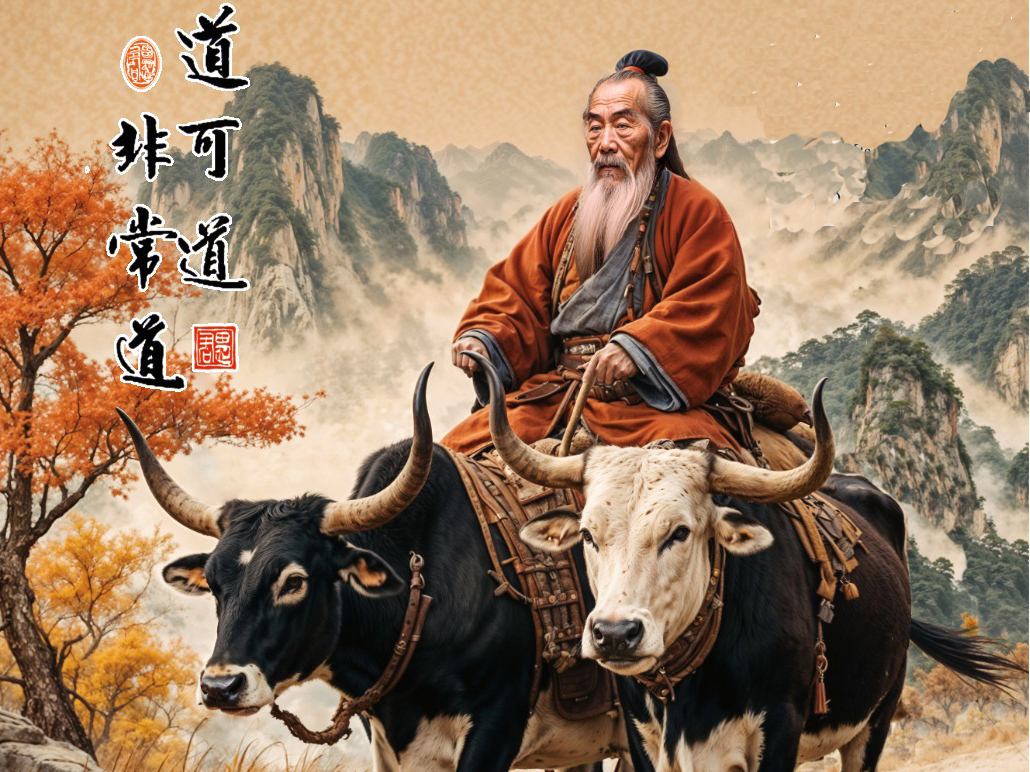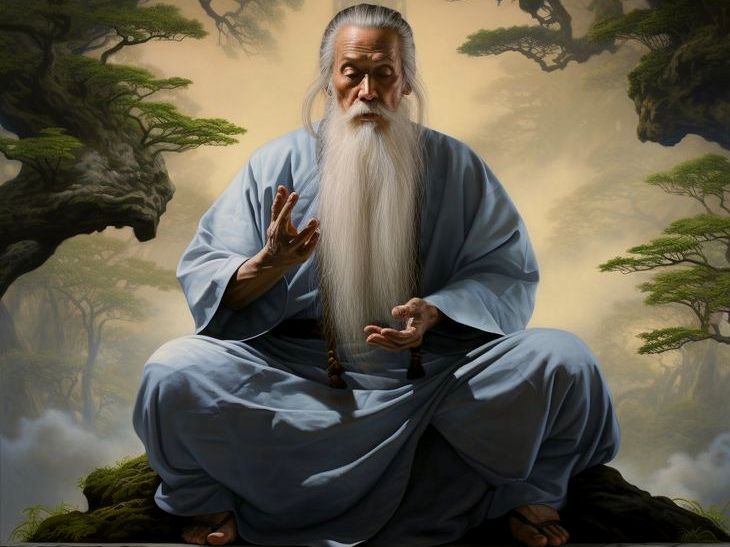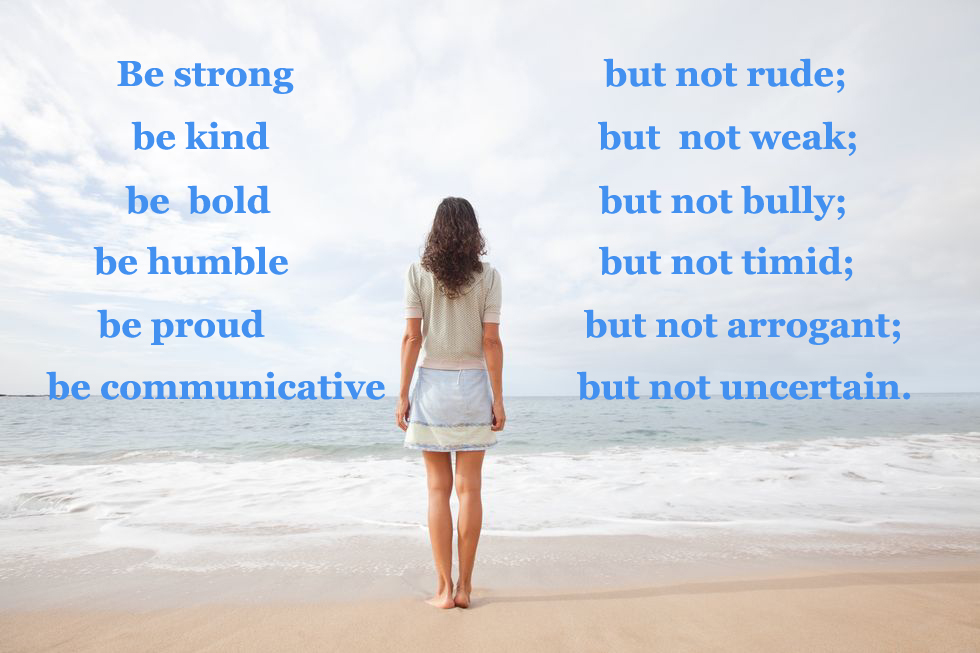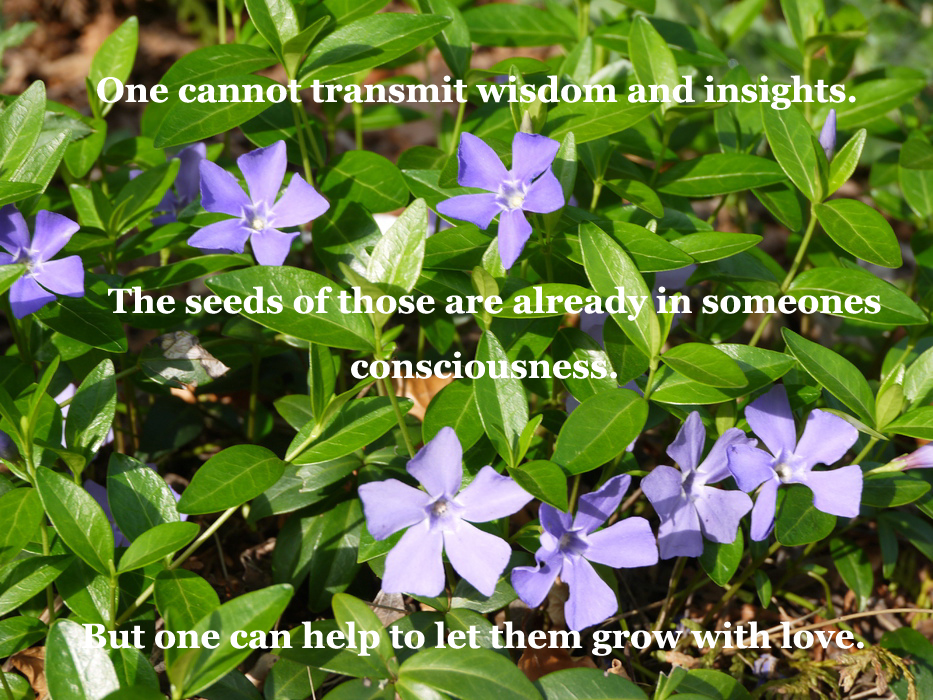Part 3
Thye modern Taoism 2.0 (part 3)
English Translation Published on 26 august 2024

The difficulty of Chinese
Up until now I have followed and reflected on Taoism from within, i.e. followed the narrative that emerges as "the philosophical system" with explicit texts from the past and implicit precepts from its history. However, this saddles the modern man, and in particular the modern Western man, with a serious number of bridging pro-blems. First of all, there is the stumbling block of language as such. One may not and cannot expect every interested person to start studying the Chinese language, but the imagery used in Taoist texts is closely related to the structure of the Chinese lan-guage and writing. A Chinese character is like a painting. A painting has a title: that is its name. For example: Le déjeuner sur 'l herbe. A Chinese character is written by a person; his calligraphy is like the style of the painter. Edouard Manet who painted Le déjeuner sur 'l herbe used the impressionist painting style. Every painter uses his own color palette and his favorite shades: those are the "words" or characters that the writer chooses. So with all those tools and aspects, the painting is the result of a certain choice and vision of the painter: he chooses a specific theme that he wants to present, and depicts it as he sees it. In this specific case, it is not a simple or average breakfast, but a special breakfast. The painting was so special and specific at the ti-me, that it caused quite a stir and scandal: it was a statement that put impressionism on the map of art.
In the same way, the writer wants to express an idea or a thought, a specific con-tent, with a text. Just as one can find a painting well painted or not, beautifully painted or not, and can interpret it according to one's own taste and preference, one can also find a text well or not well formulated because its content does or does not refer to one's own thoughts and visions. But all this does not change the content of the painting that the painter has placed in it. Likewise, the content of a text is deter-mined by its writer. The closer one, as a reader, manages to get to the original inten-tion and content of a text, the more one has understood the author's "message". TRANSLATION is therefore certainly not a matter of semantics, certainly not for Chinese: a character does not have an "absolute" but a relative meaning, depending on the context in which it is used. Sometimes it even has different meanings, or it can be used as a verb, a noun, or an adjective. Thus, under Tao can mean both "the Path" that one walks, and "the Way," or the action of "walking."
These ancient Chinese texts can therefore be translated in 50 different ways depen-ding on the interpretation of the translator. There is therefore little point in looking for the "right" or "correct" translation; one can choose the one that appeals to oneself the most. It is even important NOT to cling too much literally to the text, but to be able to read between the lines and figuratively understand the content. If one can give oneself that freedom, one can also better appreciate the rich imagery; for exam-ple, Liezi introduces characters such as "Uncle Obscure the Fuzzy", "Mr Simple" and "Master Yin of the Mountain Pass"; and Zhuangzi introduces characters such as "Know-it-all", "Non-doing, the Speechless", and "Act-on-impulse".
Up until now I have followed and reflected on Taoism from within, i.e. followed the narrative that emerges as "the philosophical system" with explicit texts from the past and implicit precepts from its history. However, this saddles the modern man, and in particular the modern Western man, with a serious number of bridging pro-blems. First of all, there is the stumbling block of language as such. One may not and cannot expect every interested person to start studying the Chinese language, but the imagery used in Taoist texts is closely related to the structure of the Chinese lan-guage and writing. A Chinese character is like a painting. A painting has a title: that is its name. For example: Le déjeuner sur 'l herbe. A Chinese character is written by a person; his calligraphy is like the style of the painter. Edouard Manet who painted Le déjeuner sur 'l herbe used the impressionist painting style. Every painter uses his own color palette and his favorite shades: those are the "words" or characters that the writer chooses. So with all those tools and aspects, the painting is the result of a certain choice and vision of the painter: he chooses a specific theme that he wants to present, and depicts it as he sees it. In this specific case, it is not a simple or average breakfast, but a special breakfast. The painting was so special and specific at the ti-me, that it caused quite a stir and scandal: it was a statement that put impressionism on the map of art.
In the same way, the writer wants to express an idea or a thought, a specific con-tent, with a text. Just as one can find a painting well painted or not, beautifully painted or not, and can interpret it according to one's own taste and preference, one can also find a text well or not well formulated because its content does or does not refer to one's own thoughts and visions. But all this does not change the content of the painting that the painter has placed in it. Likewise, the content of a text is deter-mined by its writer. The closer one, as a reader, manages to get to the original inten-tion and content of a text, the more one has understood the author's "message". TRANSLATION is therefore certainly not a matter of semantics, certainly not for Chinese: a character does not have an "absolute" but a relative meaning, depending on the context in which it is used. Sometimes it even has different meanings, or it can be used as a verb, a noun, or an adjective. Thus, under Tao can mean both "the Path" that one walks, and "the Way," or the action of "walking."
These ancient Chinese texts can therefore be translated in 50 different ways depen-ding on the interpretation of the translator. There is therefore little point in looking for the "right" or "correct" translation; one can choose the one that appeals to oneself the most. It is even important NOT to cling too much literally to the text, but to be able to read between the lines and figuratively understand the content. If one can give oneself that freedom, one can also better appreciate the rich imagery; for exam-ple, Liezi introduces characters such as "Uncle Obscure the Fuzzy", "Mr Simple" and "Master Yin of the Mountain Pass"; and Zhuangzi introduces characters such as "Know-it-all", "Non-doing, the Speechless", and "Act-on-impulse".

The pitfalls of Western thinking
Because the meaning and philosophy of Christianism in the West have had their day on the one hand and the materialistic-capitalistic model cannot provide this perspec-tive on the other hand, Western men are looking for spirituality and, against the background of the climate catastrophe, for a more natural vision of life. And so they eventually end up with Taoism, which is now experiencing a kind of "revival" as a result. In this renewed interest in the age-old Chinese ideas, they unfortunately also drag along a number of persistent thought and expectation patterns, which (can) somewhat cloud their view of it.
The first pitfall is not to interpret Taoist principles against the background of Chine-se culture, but against that of Western culture. Don't get me wrong: it is absolutely NOT necessary to identify oneself with this period of human cultural heritage from a kind of deep sympathy and nostalgia and to start walking around like a Taoist of the "old stamp". I have always found that extremely strange: Westerners who stand there chanting Krishna with a shaved head and orange robe; who, in a medieval ha-bit, relive the age of chivalry, or even the primeval time of man; or who play cowboys and Indians. No, showing respect for Taoism does not have to go that far.
But on the other hand, it is of course also very easy and tempting to distort the Tao-ist principles to Western needs and requirements. For freedom for example. The forum about Taoism where I spent some time had an immens success and response with its message of no rules. Actually that was nonsense, because when quite a few people who interpreted this too literally and just did their antisocial best on anti-social Facebook, it soon turned out that they were deleted. In the end I myself was also "banned" because I had dared to express justified criticism. No rules my ass! But anyway, it illustrates how easily one can pick one aspect of a philosophy and "infla-te" it to the only thing; I am talking about the principle of Wu Wei. Not trying to control sounds like music to the ears of the freedom-loving Westerner. With the understanding of course that this applies mainly to "the others" and less to himself.
Laissez faire laissez passer
"Letting things take their course" seems quite similar to the Western liberal model. This liberalism has as its starting point: as much freedom as possible for the indivi-dual, as long as "he does not limit the freedom of others". Liberals strive for a society in which citizens enjoy great freedoms, such as civil rights that are supposed to pro-tect the individual, and limit the power of the state and the church. That is the theory. In practice, this model always works to the advantage of those in power. That has been the case from the beginning, because both François Quesnay and Vin-cent de Gournay were advocates of the liberalization of the state monopoly on the... slave trade, before Adam Smith turned it into a political-economic philosophy with production and competition as cornerstones. That kind of "economic freedom" of free enterprise always protects the rights and advantages of the "big" and not of the "small". Ordinary citizens pay the full price in taxes and duties, while large corpora-tions manage to avoid them.
Because the meaning and philosophy of Christianism in the West have had their day on the one hand and the materialistic-capitalistic model cannot provide this perspec-tive on the other hand, Western men are looking for spirituality and, against the background of the climate catastrophe, for a more natural vision of life. And so they eventually end up with Taoism, which is now experiencing a kind of "revival" as a result. In this renewed interest in the age-old Chinese ideas, they unfortunately also drag along a number of persistent thought and expectation patterns, which (can) somewhat cloud their view of it.
The first pitfall is not to interpret Taoist principles against the background of Chine-se culture, but against that of Western culture. Don't get me wrong: it is absolutely NOT necessary to identify oneself with this period of human cultural heritage from a kind of deep sympathy and nostalgia and to start walking around like a Taoist of the "old stamp". I have always found that extremely strange: Westerners who stand there chanting Krishna with a shaved head and orange robe; who, in a medieval ha-bit, relive the age of chivalry, or even the primeval time of man; or who play cowboys and Indians. No, showing respect for Taoism does not have to go that far.
But on the other hand, it is of course also very easy and tempting to distort the Tao-ist principles to Western needs and requirements. For freedom for example. The forum about Taoism where I spent some time had an immens success and response with its message of no rules. Actually that was nonsense, because when quite a few people who interpreted this too literally and just did their antisocial best on anti-social Facebook, it soon turned out that they were deleted. In the end I myself was also "banned" because I had dared to express justified criticism. No rules my ass! But anyway, it illustrates how easily one can pick one aspect of a philosophy and "infla-te" it to the only thing; I am talking about the principle of Wu Wei. Not trying to control sounds like music to the ears of the freedom-loving Westerner. With the understanding of course that this applies mainly to "the others" and less to himself.
Laissez faire laissez passer
"Letting things take their course" seems quite similar to the Western liberal model. This liberalism has as its starting point: as much freedom as possible for the indivi-dual, as long as "he does not limit the freedom of others". Liberals strive for a society in which citizens enjoy great freedoms, such as civil rights that are supposed to pro-tect the individual, and limit the power of the state and the church. That is the theory. In practice, this model always works to the advantage of those in power. That has been the case from the beginning, because both François Quesnay and Vin-cent de Gournay were advocates of the liberalization of the state monopoly on the... slave trade, before Adam Smith turned it into a political-economic philosophy with production and competition as cornerstones. That kind of "economic freedom" of free enterprise always protects the rights and advantages of the "big" and not of the "small". Ordinary citizens pay the full price in taxes and duties, while large corpora-tions manage to avoid them.

The Vipers in the Taoist Thinking Field
The above story makes clear that there are ALWAYS rules at play: if there is no counterbalance by democratic decision-making and no control by unions and go-vernment, liberalism develops into a boundless capitalism with all its excesses. Both Nature and human nature CAN also go completely crazy, genre cataclysms and world wars, so the absolute trust that everything will automatically be fine is unjustified and misplaced. If one is bothered by the unrealistic "happy endings" of Disney films, one should also concentrate on the conditions that general principles need to work in practice, also in terms of thought and philosophy. If one dumps too much waste and pollution in nature, its natural regenerative capacity can no longer cope; the current climate disaster is proof of this. If a person is subjected to too much pressure and stress, his system can no longer cope and he falls ill; the number of medicines that are used is proof of this. And if a system of thought imposes TOO LITTLE struc-ture, it invites arbitrariness. In the other sense, this works through as: then there ARE other, more hidden rules at work to govern it. Taoism was able to function in China because there was a social and cultural direction and control, in which res-pect for the authority of the Taoist was embedded and recognized. Compare that with the right to asylum in churches: that is only possible if and as long as one is prepared to accept that ecclesiastical authority. The Vikings did not recognize that, and plundered churches.
I have experienced this during my stay in the Facebook account about Taoism that -supposedly- carried "no rules" in its banner, because this was supposedly in accor-dance with the Taoist principle. I have never seen so many people excluded from a site. It is therefore preferable to formulate rules, so that people know what they have to respect and the existence of these rules can be explained. Discussable rules can be adjusted; unspoken rules are used to manipulate people behind the scenes and silen-ce them. Nobody LEARNS anything from such censorship. Eventually I was also dis-missed from my function as moderator and even excluded as a member, because I had dared to point out that this was NOT in accordance with the Taoist principles. It will probably not be a coincidence that the admin of this site, Chris Simpson, and the above-mentioned Quesnay, de Gournay and Smith are all Gemini. Gemini -and is an Air Sign, which is not included in the Chinese Element Theory. But in Traditional Chinese Medicine, wind is associated with the Wood Element and is associated with anger and shouting, and is seen as an external "pathogenic" factor that, if it can enter the body, can disrupt the Qi (think of a cold caused by a draft). Wind is capricious and blows in all directions and through all cracks, and arbitrarily follows its own "order" which is disruptive to the normal harmony; especially when it reaches the strength of a storm or hurricane.
The above story makes clear that there are ALWAYS rules at play: if there is no counterbalance by democratic decision-making and no control by unions and go-vernment, liberalism develops into a boundless capitalism with all its excesses. Both Nature and human nature CAN also go completely crazy, genre cataclysms and world wars, so the absolute trust that everything will automatically be fine is unjustified and misplaced. If one is bothered by the unrealistic "happy endings" of Disney films, one should also concentrate on the conditions that general principles need to work in practice, also in terms of thought and philosophy. If one dumps too much waste and pollution in nature, its natural regenerative capacity can no longer cope; the current climate disaster is proof of this. If a person is subjected to too much pressure and stress, his system can no longer cope and he falls ill; the number of medicines that are used is proof of this. And if a system of thought imposes TOO LITTLE struc-ture, it invites arbitrariness. In the other sense, this works through as: then there ARE other, more hidden rules at work to govern it. Taoism was able to function in China because there was a social and cultural direction and control, in which res-pect for the authority of the Taoist was embedded and recognized. Compare that with the right to asylum in churches: that is only possible if and as long as one is prepared to accept that ecclesiastical authority. The Vikings did not recognize that, and plundered churches.
I have experienced this during my stay in the Facebook account about Taoism that -supposedly- carried "no rules" in its banner, because this was supposedly in accor-dance with the Taoist principle. I have never seen so many people excluded from a site. It is therefore preferable to formulate rules, so that people know what they have to respect and the existence of these rules can be explained. Discussable rules can be adjusted; unspoken rules are used to manipulate people behind the scenes and silen-ce them. Nobody LEARNS anything from such censorship. Eventually I was also dis-missed from my function as moderator and even excluded as a member, because I had dared to point out that this was NOT in accordance with the Taoist principles. It will probably not be a coincidence that the admin of this site, Chris Simpson, and the above-mentioned Quesnay, de Gournay and Smith are all Gemini. Gemini -and is an Air Sign, which is not included in the Chinese Element Theory. But in Traditional Chinese Medicine, wind is associated with the Wood Element and is associated with anger and shouting, and is seen as an external "pathogenic" factor that, if it can enter the body, can disrupt the Qi (think of a cold caused by a draft). Wind is capricious and blows in all directions and through all cracks, and arbitrarily follows its own "order" which is disruptive to the normal harmony; especially when it reaches the strength of a storm or hurricane.

The necessary adjustments to modern times
The Gemini principle is mental (Air) in nature, and seeks to collect and pass on all kinds of facts, news, information and knowledge. This collecting never comes to an "end" because everything in the world is in motion and innovation. The down-side of this incessant process is a superficial processing of all this "data": there is no time to internalize it, to make it one's own and to interpret it in one's own worldview, because something "new" soon presents itself. One takes a lot "through", but it also "flushes" it through; one reads a lot, but one learns little; one knows a lot, but one does not become any wiser from it. Let that be exactly what Taoism warns against. The ad nauseam quoted chapter 1 of the Tao Te Ching warns against "continuing to babble on about what Tao actually is; it exists and therefore consists". Yet that is pre-cisely what most people feel called to do: to "philosophize" about theoretical princi-ples without obligation, WITHOUT consequences for their own way of thinking and life. Yet the Conversations with Confucius in both the Liezi and the Zhuangzi indica-te that formal "discussions" only avoid the core of the matter instead of clarifying it; in the Zhuangzi one can even find a few strong examples full of brain-twists of such an absurdly advanced cerebral attitude.
What Taoism therefore advocates is not the abandonment of thinking as such - as is sometimes suggested in populist quotes - but the abandonment of the cerebral at-titude, with its dictatorship of rational thinking (left brain), its purely theoretical and distant relationship with reality, and the confusion of reality with the "idea" or "concept" that one has made of it in one's head. These are only representations, only "words" or thoughts ABOUT reality, and not that reality itself. This duality has ensured that man has been able to speak with a forked tongue since time immemo-rial: what he says and what he means are different things. In contrast, Taoism pro-poses a Unity, a holism, not starting from the "idea", but from the experience of one's lived reality. Do not theorize, but start from your own experience, and think ABOUT THAT instead of "viewing" your experience from the model in your head. That is holistic thinking (right hemisphere).
The Gemini principle is mental (Air) in nature, and seeks to collect and pass on all kinds of facts, news, information and knowledge. This collecting never comes to an "end" because everything in the world is in motion and innovation. The down-side of this incessant process is a superficial processing of all this "data": there is no time to internalize it, to make it one's own and to interpret it in one's own worldview, because something "new" soon presents itself. One takes a lot "through", but it also "flushes" it through; one reads a lot, but one learns little; one knows a lot, but one does not become any wiser from it. Let that be exactly what Taoism warns against. The ad nauseam quoted chapter 1 of the Tao Te Ching warns against "continuing to babble on about what Tao actually is; it exists and therefore consists". Yet that is pre-cisely what most people feel called to do: to "philosophize" about theoretical princi-ples without obligation, WITHOUT consequences for their own way of thinking and life. Yet the Conversations with Confucius in both the Liezi and the Zhuangzi indica-te that formal "discussions" only avoid the core of the matter instead of clarifying it; in the Zhuangzi one can even find a few strong examples full of brain-twists of such an absurdly advanced cerebral attitude.
What Taoism therefore advocates is not the abandonment of thinking as such - as is sometimes suggested in populist quotes - but the abandonment of the cerebral at-titude, with its dictatorship of rational thinking (left brain), its purely theoretical and distant relationship with reality, and the confusion of reality with the "idea" or "concept" that one has made of it in one's head. These are only representations, only "words" or thoughts ABOUT reality, and not that reality itself. This duality has ensured that man has been able to speak with a forked tongue since time immemo-rial: what he says and what he means are different things. In contrast, Taoism pro-poses a Unity, a holism, not starting from the "idea", but from the experience of one's lived reality. Do not theorize, but start from your own experience, and think ABOUT THAT instead of "viewing" your experience from the model in your head. That is holistic thinking (right hemisphere).

Conclusion
The practice of life, that's what it's all about. The Taoist priest in the video on the previous page speaks about a good foundation of life: good health or physical con-dition; good metabolism; good work; good relationships; good communication. And if there are any problems in there, solve them.
Holistic thinking has the following concrete conditions:
1/ developing one's intuition to connect with reality (Tao);
2/ thinking that does not proceed linearly, but in organic cycles (Ziran);
3/ thinking that can bridge antagonisms (Yin-Yang);
4/ thinking that responds to what exists instead of trying to adapt it to a plan (Wu Wei);
5/ and finally thinking that starts from and translates into one's own life practice (Wan Zheng).
Without that, even the most beautiful and highly inspired texts remain dead letters. Because the foundations of life are built from BELOW = for and from his concrete life, and not from ABOVE = for and from his philosophy.
So we must be careful NOT to try to describe our lives in Taoist terms or to reduce them to the Taoist framework like the first best "professional idiot". No, we must use Taoist thought to think about life, and about our own life in particular. And be aware that as a 2000 year old heritage it cannot provide answers to all questions in the 21st century. The "no rules" does NOT work - the fiasco of the sixties has proven this tho-roughly -; but discussability of the usefulness of the rules and principles does, be-cause it allows them to be adapted or adjusted. It would be wrong to give up OUR modern achievements and freedoms, in order to want to return in a kind of "time capsule" to the China of 2000 years ago. Just as acupuncture and Traditional Chine-se Medicine have their effectiveness in 2024, and Tai Chi can be practiced, Taoist thinking can be used by dealing with it plastically. After all, this is completely in ac-cordance with the essence of Taoism itself (everything is subject to change), and Taoism itself needs this to become "alive" again from instead of staying a kind of re-lic of the past.
The practice of life, that's what it's all about. The Taoist priest in the video on the previous page speaks about a good foundation of life: good health or physical con-dition; good metabolism; good work; good relationships; good communication. And if there are any problems in there, solve them.
Holistic thinking has the following concrete conditions:
1/ developing one's intuition to connect with reality (Tao);
2/ thinking that does not proceed linearly, but in organic cycles (Ziran);
3/ thinking that can bridge antagonisms (Yin-Yang);
4/ thinking that responds to what exists instead of trying to adapt it to a plan (Wu Wei);
5/ and finally thinking that starts from and translates into one's own life practice (Wan Zheng).
Without that, even the most beautiful and highly inspired texts remain dead letters. Because the foundations of life are built from BELOW = for and from his concrete life, and not from ABOVE = for and from his philosophy.
So we must be careful NOT to try to describe our lives in Taoist terms or to reduce them to the Taoist framework like the first best "professional idiot". No, we must use Taoist thought to think about life, and about our own life in particular. And be aware that as a 2000 year old heritage it cannot provide answers to all questions in the 21st century. The "no rules" does NOT work - the fiasco of the sixties has proven this tho-roughly -; but discussability of the usefulness of the rules and principles does, be-cause it allows them to be adapted or adjusted. It would be wrong to give up OUR modern achievements and freedoms, in order to want to return in a kind of "time capsule" to the China of 2000 years ago. Just as acupuncture and Traditional Chine-se Medicine have their effectiveness in 2024, and Tai Chi can be practiced, Taoist thinking can be used by dealing with it plastically. After all, this is completely in ac-cordance with the essence of Taoism itself (everything is subject to change), and Taoism itself needs this to become "alive" again from instead of staying a kind of re-lic of the past.
